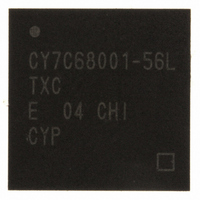CY7C68001-56LTXC Cypress Semiconductor Corp, CY7C68001-56LTXC Datasheet - Page 10

CY7C68001-56LTXC
Manufacturer Part Number
CY7C68001-56LTXC
Description
IC USB EZ-USB SX2 HS 56VQFN
Manufacturer
Cypress Semiconductor Corp
Series
CY7Cr
Type
USBr
Specifications of CY7C68001-56LTXC
Protocol
USB 2.0
Voltage - Supply
3 V ~ 3.6 V
Mounting Type
Surface Mount
Package / Case
56-VQFN Exposed Pad, 56-HVQFN, 56-SQFN, 56-DHVQFN
Lead Free Status / RoHS Status
Lead free / RoHS Compliant
Number Of Drivers/receivers
-
Lead Free Status / Rohs Status
Lead free / RoHS Compliant
Other names
428-2932
Available stocks
Company
Part Number
Manufacturer
Quantity
Price
Part Number:
CY7C68001-56LTXC
Manufacturer:
CYPRESS/赛普拉斯
Quantity:
20 000
3.3.2
An optional default descriptor can be used to simplify enumeration. Only the Vendor ID (VID), Product ID (PID), and Device ID
(DID) need to be loaded by the SX2 for it to enumerate with this default set-up. This information is either loaded from an EEPROM
in the case when the presence of an EEPROM (Table 3-1) is detected, or the external master may simply load a VID, PID, and
DID when no EEPROM is present. In this default enumeration, the SX2 uses the in-built default descriptor (refer to Section 12.0).
If the descriptor length loaded from the EEPROM is 6, SX2 will load a VID, PID, and DID from the EEPROM and enumerate. The
VID, PID, and DID are loaded LSB, then MSB. For example, if the VID, PID, and DID are 0x0547, 0x1002, and 0x0001, respec-
tively, then the bytes should be stored as:
If there is no EEPROM, SX2 will wait for the external master to provide the descriptor information. To use the default descriptor,
the external master must write to the appropriate register (0x30) with descriptor length equal to 6 followed by the VID, PID, and
DID. Refer to Section 4.2 for further information on how the external master may load the values.
The default descriptor enumerates four endpoints as listed in the following page:
The entire default descriptor is listed in Section 12.0 of this data sheet.
3.4
3.4.1
The SX2 provides an output signal that indicates to the external master that the SX2 has an interrupt condition, or that the data
from a register read request is available. The SX2 has six interrupt sources: SETUP, EP0BUF, FLAGS, ENUMOK, BUSACTIVITY,
and READY. Each interrupt can be enabled or disabled by setting or clearing the corresponding bit in the INTENABLE register.
When an interrupt occurs, the INT# pin will be asserted, and the corresponding bit will be set in the Interrupt Status Byte. The
external master reads the Interrupt Status Byte by strobing SLRD/SLOE. This presents the Interrupt Status Byte on the lower
portion of the data bus (FD[7:0]). Reading the Interrupt Status Byte automatically clears the interrupt. Only one interrupt request
will occur at a time; the SX2 buffers multiple pending interrupts.
If the external master has initiated a register read request, the SX2 will buffer interrupts until the external master has read the
data. This insures that after a read sequence has begun, the next interrupt that is received from the SX2 will indicate that the
corresponding data is available. Following is a description of this ITENABLE register.
3.4.2
Bit 7: SETUP
If this interrupt is enabled, and the SX2 receives a set-up packet from the USB host, the SX2 asserts the INT# pin and sets bit 7
in the Interrupt Status Byte. This interrupt only occurs if the set-up request is not one that the SX2 automatically handles. For
complete details on how to handle the SETUP interrupt, refer to Section 5.0 of this data sheet.
Bit 6: EP0BUF
If this interrupt is enabled, and the Endpoint 0 buffer becomes available to the external master for read or write operations, the
SX2 asserts the INT# pin and sets bit 6 in the Interrupt Status Byte. This interrupt is used for handling the data phase of a set-up
request. For complete details on how to handle the EP0BUF interrupt, refer to Section 5.0 of this data sheet.
Bit 5: FLAGS
If this interrupt is enabled, and any OUT endpoint FIFO’s state changes from empty to not-empty, the SX2 asserts the INT# pin
and sets bit 5 in the Interrupt Status Byte. This is an alternate way to monitor the status of OUT endpoint FIFOs instead of using
the FLAGA-FLAGD pins, and can be used to indicate when an OUT packet has been received from the host.
Bit 4: ENUMOK
If this interrupt is enabled and the SX2 receives a SET_CONFIGURATION request from the USB host, the SX2 asserts the INT#
pin and sets bit 2 in the Interrupt Status Byte. This event signals the completion of the SX2 enumeration process.
Document #: 38-08013 Rev. *B
• Descriptor Length: The next two bytes indicate the length of the descriptor contained in the EEPROM. The length is loaded
• Byte 7 Starts Descriptor Information: The descriptor can be a maximum of 500 bytes.
• 0x47, 0x05, 0x02, 0x10, 0x01, 0x00.
• Endpoint 2: Bulk out, 512 bytes in high-speed mode, 64 bytes in full-speed mode
• Endpoint 4: Bulk out, 512 bytes in high-speed mode, 64 bytes in full-speed mode
• Endpoint 6: Bulk in, 512 bytes in high-speed mode, 64 bytes in full-speed mode
• Endpoint 8: Bulk in, 512 bytes in high-speed mode, 64 bytes in full-speed mode.
least significant byte (LSB) first, then most significant byte (MSB).
Default Enumeration
Interrupt System
Architecture
ITENABLE Register Bit Definition
CY7C68001
Page 10 of 50













